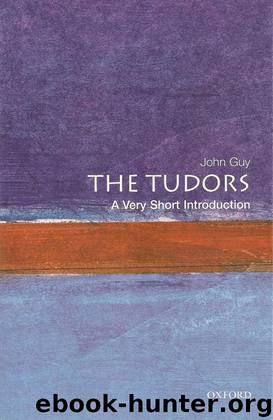The Tudors: A Very Short Introduction by Guy John

Author:Guy, John [Guy, John]
Language: eng
Format: mobi, epub
Publisher: Oxford University Press
Published: 2000-08-10T00:00:00+00:00
The Court of Philip and Mary
Philip was accorded his own royal household. The queen’s household was located in what, during her father’s and brother’s reigns, was the part of the royal palaces usually known as ‘the king’s side’; Philip’s court occupied what had formerly been the queen’s or consort’s apartments, but at the leading palace of Whitehall, these apartments had originally been those of Cardinal Wolsey, and were actually grander and more spacious than the rooms on Mary’s side of the court. Whereas Mary’s household was relatively small, Philip’s must have had difficulty in accommodating itself within the available space. The king brought a full chamber staff with him from Spain only to find another waiting for him in England complete with a guard of 100 archers. A compromise was reached that Philip should use Spaniards almost exclusively in his privy chamber, leaving his English servants to perform outer chamber and ceremonial duties.
If the evidence of public spectacle and the material culture is anything to go by, political and ideological divisions, or any sense of insecurity in the monarchy, were absent in this reign. There was a confident and unreserved commitment to magnificence and the ‘imagination’ of majesty on behalf of the king and queen. Outdoor events and processions were staged on a large scale, and were as dramatic and successful as the indoor ceremonies and entertainments. Vast quantities of luxury goods were requisitioned. Their distribution was not narrowly confined: an inclusive policy was adopted, and as many courtiers as possible cashed in on the perks. Resident ambassadors as well as the nobility, privy councillors, and the lesser members of the royal households received generous allowances. Public ceremonies sought to project the profile of the dual monarchy. The opening of Parliament was preceded by masses and ornate processions involving Spanish as well as English noblemen and courtiers, and elaborate requiems were held for Philip’s grandmother, Juana, sometime queen of Castile, in June 1555, and for John III, king of Portugal, in October 1557.
Mary revived the ceremony for the blessing of cramp rings on Good Friday. She also touched for scrofula, or ‘the king’s evil’, and eagerly participated in the ceremonies for Maundy Thursday in which she washed the feet of a number of poor women corresponding to her age. Whereas Henry VIII spent an average of £63 on the annual Maundy ceremony, Mary’s honour required an outlay of £160.
At the requiem for Queen Juana at St Paul’s Cathedral, the Spanish and English nobility led the solemn procession, walking side by side, headed by the count de Feria and the marquis of Winchester. There followed the imperial, French, Venetian, and Portuguese ambassadors, the clergy, and a small army of mourners carrying banners and escutcheons decorated with gold and silver. A magnificent hearse was constructed of wax over a timber frame with an ornamental dome and gilded canopy. Wax alone for the four staff torches that surrounded the hearse weighed 1,231 lbs, and the event was reminiscent of no lesser an event than the funeral of Henry VIII.
Download
The Tudors: A Very Short Introduction by Guy John.epub
This site does not store any files on its server. We only index and link to content provided by other sites. Please contact the content providers to delete copyright contents if any and email us, we'll remove relevant links or contents immediately.
| France | Germany |
| Great Britain | Greece |
| Italy | Rome |
| Russia | Spain & Portugal |
Fanny Burney by Claire Harman(26566)
Empire of the Sikhs by Patwant Singh(23026)
Out of India by Michael Foss(16824)
Leonardo da Vinci by Walter Isaacson(13239)
Small Great Things by Jodi Picoult(7076)
The Six Wives Of Henry VIII (WOMEN IN HISTORY) by Fraser Antonia(5459)
The Wind in My Hair by Masih Alinejad(5060)
A Higher Loyalty: Truth, Lies, and Leadership by James Comey(4909)
The Lonely City by Olivia Laing(4774)
The Crown by Robert Lacey(4766)
Millionaire: The Philanderer, Gambler, and Duelist Who Invented Modern Finance by Janet Gleeson(4425)
The Iron Duke by The Iron Duke(4325)
Papillon (English) by Henri Charrière(4230)
Sticky Fingers by Joe Hagan(4148)
Joan of Arc by Mary Gordon(4058)
Alive: The Story of the Andes Survivors by Piers Paul Read(3999)
Stalin by Stephen Kotkin(3922)
Aleister Crowley: The Biography by Tobias Churton(3606)
Ants Among Elephants by Sujatha Gidla(3442)
